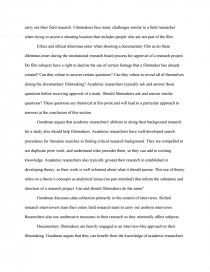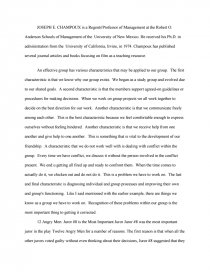12 Angry Men
Essay by review • December 24, 2010 • Research Paper • 10,479 Words (42 Pages) • 5,015 Views
Essay Preview: 12 Angry Men
Though all 12 jurors are white men, they are a varied crew. They attempt to sit still around the heavy table at the centre of Allen Moyer's set, but in their passion keep leaping up to pace the room, mop their brows and peer out at an oppressively humid New York day. Relying on their analytic abilities - this is the 1950s, years before fancy forensics determined verdicts - they pore over the details of the case. If Rose's dialogue makes one wish occasionally for the more clipped speed of cop-show patter on today's TV, his story's construction is impeccable. This is thrilling drama.
Full Text (356 words)
(Copyright Financial Times Ltd. 2004. All rights reserved.)
Such is the intensity of America's presidential campaign that almost any play can seem loaded with topical meaning. With Reginald Rose's Twelve Angry Men, a Roundabout Theatre revival, the idea that in 90 minutes one man could persuade 11 fellow jurors, many of them at first dogmatic, of his views in a murder case seems fantastical. In an era of excruciating partisanship, such a faith in rhetoric, in the swaying power of evidence, appears antediluvian.
Yet such is the force of Scott Ellis's production that we not only accept such a situation but even, occasionally, are tempted to cheer it. There is something restorative about the triumph of decency, even though our faith in it may have evaporated by the time we step outside the theatre. As the initial dissenter in the case - which involves a 16-year-old who has allegedly knifed his father to death - Boyd Gaines, as Juror Number Eight, oozes forthrightness, and as usual the actor puts one in mind of Jimmy Stewart - which at least distracts us from comparing him with the role's movie interpreter, Henry Fonda.
I have never seen the story's original incarnation, a TV movie of 1954. In the feature adaptation, as in a 1997 remake with that avatar of earnestness, Jack Lemmon, Juror Number Eight tended to dominate. Not so at the Roundabout: it is the excellence of the ensemble that makes the evening succeed.
Though all 12 jurors are white men, they are a varied crew. They attempt to sit still around the heavy table at the centre of Allen Moyer's set, but in their passion keep leaping up to pace the room, mop their brows and peer out at an oppressively humid New York day. Relying on their analytic abilities - this is the 1950s, years before fancy forensics determined verdicts - they pore over the details of the case. If Rose's dialogue makes one wish occasionally for the more clipped speed of cop-show patter on today's TV, his story's construction is impeccable. This is thrilling drama. Tel +1 212 719 1300 More on ft.com/arts: 'Irrelohe', Vienna Volksoper, and the Hong Kong Philharmonic Orchestra
This article describes the use of selected vignettes from the updated version of the film 12 Angry Men in a facilitated discussion to teach the principles of dialogue. Dialogue is a process for transforming traditional conversation--characterized by defensive routines, agendas, and ineffective listening practices--into a communication strategy that can help individuals and organizations. The exercise may be tailored for use with undergraduate and graduate students, as well as practicing managers and executives, to illustrate barriers to effective communication and decision making and to identify strategies to overcome those barriers.
Journal of Management Education, Vol. 29, No. 6, 792-815 (2005)
DOI: 10.1177/1052562905277183
© 2005 The Organizational Behavior Teaching Society
Using Motion Pictures to Teach Management: Refocusing the Camera Lens Through the Infusion Approach to Diversity
Minnette A. Bumpus
Howard University
Motion pictures and television shows can provide mediums to facilitate the learning of management and organizational behavior theories and concepts. Although the motion pictures and television shows cited in the literature cover a broad range of cinematic categories, racial inclusion is limited. The objectives of this article are to document the exclusivity, provide possible explanations for the exclusivity, expand the current literature by providing motion picture options that feature actors of color in leading roles, demonstrate that movies with actors of color in leading roles are applicable for teaching topics other than diversity, and advocate an infusion approach to diversity.
Key Words: communication * diversity * leadership * motivation * newventures * perception * role conflict
12 Angry Men
12 Angry Men, starring Henry Fonda, was shot in black and white and runs for 92 minutes. The plot concerns a jury of 12 White men discussing their verdict in a trial in which an 18-year-old Spanish American boy is accused of murdering his father. The prosecution case is strong; the defense is weak. Initially, 11 jurors vote guilty. One (Fonda) feels that there is reasonable doubt. A guilty verdict will lead to a mandatory death sentence. The jury eventually decides not guilty after Fonda persuades each of the jurors in turn to change their minds. The achievement of Fonda's character generates the plot of the film and provides the basis for an analysis of the interpersonal influence process.
Apart from the contextualizing sequence at the beginning and the final courtroom and departure scenes, the action takes place around the table in the jury room. Most characters are identified by occupation or personal characteristics rather than by name and represent a broad social mix: sports coach (jury foreman), bank clerk, owner of messenger service, stockbroker, man from slums, house painter, baseball fan, architect (Fonda), old man, garage owner, watchmaker, and advertising man.
Following our critical interrogation approach, what is the thesis of this film? The central thesis appears to be that jury decisions are not based exclusively on a rational consideration of the evidence presented but are colored by contextual, temporal, processual, social, and emotional factors and on a range of overt and covert influencing tactics. The event sequence of the film revolves around a series of influence attempts, through which Fonda's character gradually turns the jury to deliver a not guilty verdict, thus saving the defendant's life. The explanation for this outcome lies with the combination of factors summarized in Table 2.
Enlarge
...
...



































